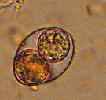Difference between revisions of "Coccidiosis - Cat & Dog"
| (10 intermediate revisions by 3 users not shown) | |||
| Line 1: | Line 1: | ||
| − | [[ | + | {{OpenPagesTop}} |
| − | + | == Introduction == | |
| + | Coccidiosis in cats and dogs is much rarer than the common disease presentation in [[Coccidiosis - Cattle|ruminants]] and [[Coccidiosis - Poultry|poultry]]. Transmission of [[:Category:Coccidia|coccidia]] is via the faeco- oral route; ingestion of the oocysts. | ||
| − | + | [[Isospora spp.|''Isospora'' species]] of coccidia are found in the cat (two) and dog (two common and two less common). Neither are of clinical significance. Often the animal must be immunosuppressed or in very poor condition in order for the disease to occur as small numbers of oocysts are not pathogenic. Even if the faecal oocyst count is high, other causes of diarrhoea should be investigated. Both species of ''Isospora'' have little pathogenicity. | |
| − | + | <center><gallery> | |
| − | [[Category: | + | Image:Isospora felis sporulated.jpg|<i>Isospora felis</i> sporulated - Courtesy of the Laboratory of Parasitology, University of Pennsylvania School of Veterinary Medicine |
| + | Image:Isospora canis.jpg|<i>Isospora canis</i> - Joaquim Castellà Veterinary Parasitology Universitat Autònoma de Barcelona | ||
| + | Image:Isospora felis.jpg|<i>Isospora felis</i> - Joaquim Castellà Veterinary Parasitology Universitat Autònoma de Barcelona | ||
| + | Image:Isospora felis unsporulated.jpg|<i>Isospora felis</i> unsporulated - Courtesy of the Laboratory of Parasitology, University of Pennsylvania School of Veterinary Medicine | ||
| + | Image:Coccidia logo.jpg|<i>Coccidia in Cat Faeces</i> <br /> Joel Mills, WikiMedia Commons | ||
| + | </gallery></center> | ||
| + | |||
| + | ==Clinical Signs == | ||
| + | |||
| + | Diarrhoea and weight loss. There may be anorexia and fever in severe cases. | ||
| + | |||
| + | == Diagnosis == | ||
| + | |||
| + | Presence of a very high number of oocysts in the faeces, plus previous exclusion of other causes of diarrhoea. History of overcrowding or unhygienic conditions may also be indicative. | ||
| + | |||
| + | Oocysts in faeces have to be distinguished from those of [[Toxoplasma gondii|''Toxoplasma'']] (smaller) and ''[[Sarcocystis]]'' (sporulated or naked sporocyts in faeces).<br> | ||
| + | |||
| + | == Treatment and Control == | ||
| + | |||
| + | Sulfonamthoxine or Trimethoprin are the treatment of choice in cats and dogs. | ||
| + | |||
| + | Investigation should be undertaken into living conditions of the animal, or pre-existing medical conditions that may make the animal susceptible. | ||
| + | |||
| + | == References == | ||
| + | |||
| + | Fox, M and Jacobs, D. (2007) Parasitology Study Guide Part 1: Ectoparasites Royal Veterinary College | ||
| + | |||
| + | Hall, E.J, Simpson, J.W. and Williams, D.A. (2005) BSAVA Manual of Canine and Feline Gastroenterology (2nd Edition) BSAVA | ||
| + | |||
| + | Tilley, L.P. and Smith, F.W.K.(2004)The 5-minute Veterinary Consult (Third edition) Lippincott, Williams & Wilkins. | ||
| + | |||
| + | |||
| + | {{review}} | ||
| + | |||
| + | {{OpenPages}} | ||
| + | [[Category:Intestinal Diseases - Cat]][[Category:Expert_Review]] | ||
| + | [[Category:Intestinal Diseases - Dog]] | ||
Latest revision as of 17:57, 5 July 2012
Introduction
Coccidiosis in cats and dogs is much rarer than the common disease presentation in ruminants and poultry. Transmission of coccidia is via the faeco- oral route; ingestion of the oocysts.
Isospora species of coccidia are found in the cat (two) and dog (two common and two less common). Neither are of clinical significance. Often the animal must be immunosuppressed or in very poor condition in order for the disease to occur as small numbers of oocysts are not pathogenic. Even if the faecal oocyst count is high, other causes of diarrhoea should be investigated. Both species of Isospora have little pathogenicity.
Clinical Signs
Diarrhoea and weight loss. There may be anorexia and fever in severe cases.
Diagnosis
Presence of a very high number of oocysts in the faeces, plus previous exclusion of other causes of diarrhoea. History of overcrowding or unhygienic conditions may also be indicative.
Oocysts in faeces have to be distinguished from those of Toxoplasma (smaller) and Sarcocystis (sporulated or naked sporocyts in faeces).
Treatment and Control
Sulfonamthoxine or Trimethoprin are the treatment of choice in cats and dogs.
Investigation should be undertaken into living conditions of the animal, or pre-existing medical conditions that may make the animal susceptible.
References
Fox, M and Jacobs, D. (2007) Parasitology Study Guide Part 1: Ectoparasites Royal Veterinary College
Hall, E.J, Simpson, J.W. and Williams, D.A. (2005) BSAVA Manual of Canine and Feline Gastroenterology (2nd Edition) BSAVA
Tilley, L.P. and Smith, F.W.K.(2004)The 5-minute Veterinary Consult (Third edition) Lippincott, Williams & Wilkins.
| This article has been peer reviewed but is awaiting expert review. If you would like to help with this, please see more information about expert reviewing. |
Error in widget FBRecommend: unable to write file /var/www/wikivet.net/extensions/Widgets/compiled_templates/wrt665a4acb726d24_40989839 Error in widget google+: unable to write file /var/www/wikivet.net/extensions/Widgets/compiled_templates/wrt665a4acb766ce2_87608900 Error in widget TwitterTweet: unable to write file /var/www/wikivet.net/extensions/Widgets/compiled_templates/wrt665a4acb7a0804_78371672
|
| WikiVet® Introduction - Help WikiVet - Report a Problem |




